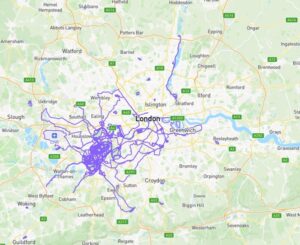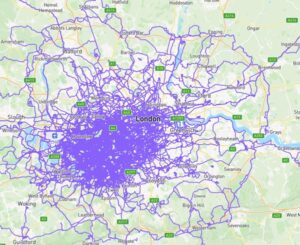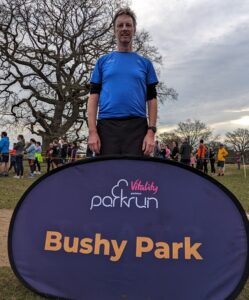Happy New Year!
 As well as being the start of a new year, today marks ten years since I started this blog so I thought I would have a look back at what I have achieved and some of the experiences I have had over the last ten years.
As well as being the start of a new year, today marks ten years since I started this blog so I thought I would have a look back at what I have achieved and some of the experiences I have had over the last ten years.
I actually started walking in 2012 when I finally gave up on my on and off running career which for the previous 30 years had been more about being injured than actually running, but it wasn’t until the second half of 2014 that I got serious about long distance walking and it was on New Year’s Eve 2014 that I decided I would start documenting my walking adventures via this blog.
So, here are ten highlights of my last ten years of walking:
-
500km in a month:
In January 2015 I walked 500km (in a month) for the first time ever – or at least I thought I did, but on checking just now I see I only walked 470km, but I also ran 36km because I was still doing a bit of running way back then.
Who would have thought that ten years later 500km in a month would be the minimum distance I would cover when I’m in full training for my annual pilgrimage to France for the 6 Jours de France 6-day race each year. -
6 day racing:
Ten years ago I had completed three walks of over 100 miles (161km) – the 2013 New Zealand Centurions race, the 2014 UK Centurions race and the 201 Roubaix 28 hour race.
It was the 2014 UK Centurions race where I met Kathy Crilley who suggested that I might be interested in joining some British walkers at Roubaix 6 weeks later. And it was at Roubaix where I met Suzanne Beardsmore, although both her and Sarah Lightman – the other key person in my walking adventures of the last ten years – had also competed in the UK Centurions race in 2014.
Kathy and Suzanne are 100% to blame for what has now become my obsession with 6-day racing.
In August 2015 Suzanne and Kathy competed in the 6 Jours de France but I decided that 6 days of walking around a 1km circuit was too far for me, but the accompanying 72 hour race would be do-able.
I was wrong. 72 hours was too much for me and I only completed 43km in the third day for a total distance of 283km.
But I was hooked, and in 2016 I completed my first 6-day race (614km) along with Kathy and Suzanne.
We went back again in 2017 (500km) and 2018 (564km).
In 2019 we decided to take a break from 6-day racing before another attempt in 2020, but 2020 was cancelled due to the pandemic and the 2021 race wasn’t possible either due to travel restrictions at the tail end of the pandemic.
In 2022 (667km), 2023 (711km) and 2024 (671km) I found my calling and I can honestly say that there isn’t a day that goes by without me thinking about 6-day racing – either thinking about one or more of my six 6-day races to date, or thinking about my next 6-day race, or the amazing friends I’ve made because of those races. -
Sarah, Suzanne and Kathy:
And speaking of friends, Sarah, Suzanne and Kathy have been a major part of my walking over the last ten years.
When I started writing this blog post I thought I would write about my highlights from the last ten years. My friendship with Sarah, who has been my support crew at my last three 6-day races plus Roubaix 28 hour race in 2015 and Royan 48 hour race in 2024, Suzanne and Kathy, would have to be the highlight!
We have been through many highs and lows together. Endurance sport is great for bonding people together and I’m grateful for my friendship with these three people.
Team photo before the start of the 2022 6 Jours de France – Sarah, me, Suzanne and Kathy -
M25 circumnavigation:
I remember when we first moved to England in 2008, and the first time I drove on the M25 and learning that it circumnavigated London. The idea of completing that same circle around London under my own power was born. At the time I was doing some running but even although I had run 100km a few times, the idea of running the 250+ kilometres around the outside of the M25 was more than thought I could ever do.
In 2009 I trained for the UK Ironman, and I considered the possibility of cycling the lap, but that never happened.
But in 2016 I decided to see if I could walk a lap around the outside of the M25. Being a motorway, I couldn’t walk on the M25 itself, but I mapped out a clockwise loop starting under the Dartford Bridge and staying as close as possible to the M25 but not crossing under or over it.
Sarah was my support crew for this adventure too, and she was joined by Suzanne plus Suzanne’s husband, Jim, on day 2.
Unfortunately, I wasn’t mentally strong enough to complete the loop and I gave up after 30 odd hours. I went back two days later and completed the lap, but it wasn’t a victory in my mind so in 2017 I went back and completed the full 250+ kilometre loop anticlockwise in 44 hours non-stop, and with support from a few friends who lived nearby various places that I would pass. Another example of friendships made through sport.
I still consider my 2017 circumnavigation of the M25 to be one of my greatest achievements – made even more difficult by my self-imposed rule that I couldn’t sit down from when I started until I finished. -
270 Tube Stations:
In 2020, in between the two major UK lockdowns, but without any opportunities to compete in any races I decided to see if I could visit all 270 London Underground tube stations on foot.
It took me just under six days to cover the 525km starting and finishing at my closest tube station, Richmond. I did have a 24 hour break in the middle because of my inability to sleep rough, but this is definitely one of the highlights of my last ten years.
Incidentally, TFL have since opened two more tube stations, and I think if I was to arrange for people to meet me on course to give me food and somewhere warm to sleep when needed it, I could complete all 272 stations in under four days. Just an idea … -
100 miles or more:
At the beginning of 2015 I had completed three walks of 100 miles or more. That number is now 47. 43 in races and 4 in “adventure walks” such as the M25 and tube station walks
So obviously that means that I’ll complete my 50th walk of 100 miles or more in 2025. I don’t know where or when yet, but if my training goes to plan I will have a 100+ mile adventure walk in February and then the 2025 6 Jours de France will be number 49, so I’m probably looking at the second half of 2025. -
London map:
I named this blog Richard Walks London because already by the end of 2014 I was starting to walk all over London, and that has continued during the last ten years. The CityStrides app has enabled me to see my progress and also identify in real time while out walking whether or not I have walked long a particular street. I’ve got a long way to go if I want to live up to the name of this blog and walk all over London, but let’s see where I’m at in another ten years!
These two maps show where I had walked in London as at 31 December 2014 and as at yesterday, 31 December 2024. -
Ultramarathons:
Over the last ten years I’ve competed in various running ultramarathons such as the Grans Union Canal Race (Birmingham to London), Kennett & Avon Canal Race (London to Brighton), Dublin to Belfast, Lon Las Ultra (Holyhead to Cardiff), Thames Ring (a 250 mile loop following the Thames, Grans Union Canal and Oxford Canal) and several other races.
If I could, I would do them all every year. They are great adventures, and I’ve made so many friends through these races. -
NZ records:
Being from a small country that doesn’t have a long history of ultra-distance race-walking meant that as I improved I found myself in a position to break the existing New Zealand records for all distances from 100 miles and 24 hours up to six days.
The first was the NZ 200km record at Roubaix in 2015 thanks to the support Sarah gave me throughout that race, and since then there have been NZ road and track records plus age group records on a regular basis.
My 2022 and 2023 six-day results were also Commonwealth records and my 2024 six-day race was a World age group record!
I’m proud to have done this and hopefully one day someone will see my times and distances as targets that they can chase, just like I have done over the last ten years.
I think I can still improve most of my times/distances, possibly with the exception of 100 miles and 24 hours, but my focus is well and truly on 6 days and therefore it is unlikely that I’ll chase the shorter distances in the near future.
A full list of all New Zealand walking records can be found here. -
40,000 kilometres:
Believe it or not, I’ve walked 40,810km in the last ten years – slightly further than one lap around the equator!
That 40,810km has taken me 6,228 hours and 49 minutes (plus 46 seconds). That’s over eight months of non-stop walking!
I’m sure there are many other things I could have done in those 6,228 hours, but would I have got more out of other activities than walking? I doubt it.
One important thing to mention here is that I am forever grateful to my wife, Ruth, for allowing me to spend so much time enjoying my sport, training, travelling to races, etc.
Thanks Ruth.
The future:
At this time of the year, I don’t like to think past the 6 Jours de France, which this year starts on 28th April. I’ll start my 16 week training plan on the 12th January. The plan will be very similar to what I’ve done over the last three years – three x 100 miles per week followed by a shorter week, repeated three times, and then a taper through to the race.
I’m both looking forward to it and scared of it. I love the early morning walks – 3 to 5 hours before work on Tuesday through Friday, and then a long walk on Saturday – but I also know how hard it is, and that is what I’m scared of.
But if things go to plan, in early May I will have another highlight to add to this list.






 Even although I have made a deliberate attempt to reduce my Coca Cola consumption in recent years, I still consume at least two large bottles (about 3 litres in total) of Coke every weekend. So I am committing to not drinking any Coke at any time between January 1st and at least mid-March (my wife’s birthday).
Even although I have made a deliberate attempt to reduce my Coca Cola consumption in recent years, I still consume at least two large bottles (about 3 litres in total) of Coke every weekend. So I am committing to not drinking any Coke at any time between January 1st and at least mid-March (my wife’s birthday).